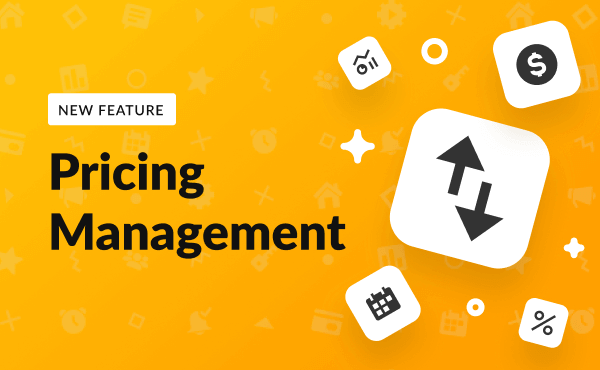How Does Airbnb Dynamic Pricing Drive Revenue Growth?

Using dynamic pricing on Airbnb or other vacation rental platforms is a common yet effective practice to maximize your hosting revenue.
However, when it comes to implementing new pricing strategies in your business, it’s useful to look at the relevant data and stats first. And speaking of data, hosts and property managers who have introduced dynamic pricing report that their profits have grown by 10-40%.
Are you ready to optimize your pricing and ensure you don’t leave money on the table? Continue reading to discover the ins and outs of implementing dynamic Airbnb pricing for your listing.

What Is Dynamic Airbnb Pricing?
Dynamic pricing is pricing for your short-term rental property that changes in real-time based on various fluctuations in the market. These fluctuations include changes in demand and supply, seasonality, events in the area, etc.
Dynamic pricing goes beyond just setting different rates for high and low seasons. Keeping your prices dynamic means they get adjusted in response to the slightest changes in the price-influencing factors.
What Is an Airbnb Dynamic Pricing Tool?
Besides vacation rental software, which is the most popular technology that hosts use, there are other Proptech solutions that are worth considering. A dynamic pricing tool is a software solution that helps hosts and property managers automatically optimize their listings’ prices.
You don’t need to spend long hours researching trends on the market to figure out the best pricing for your listing at this very moment. A dynamic pricing tool uses a smart algorithm that analyzes the most important market data points and refreshes your prices every 24 hours.
There are many dynamic pricing tools on the market. The most popular are those that have integrations with a number of vacation rental software solutions like iGMS. For instance, as an iGMS user, you can use Pricelabs or DPGO pricing tools as they are integrated with this software.
Why Using a Flat Pricing Strategy Is Not a Good Idea for a Short-term Rental Business
When it comes to pricing, a set-and-forget-it approach might look easy to implement. However, if you are determined to grow your business, this approach won’t help it go a long way. Let’s take a look at why flat pricing strategies are not the best idea for your vacation rental business.
1. Optimizing only for maximum occupancy rate
Let’s imagine that John is an Airbnb host and strives for a maximum occupancy rate. He charges a slightly lower rate than his competitors and has got his calendar booked for months ahead. John doesn’t tweak his pricing no matter the season or day of the week and finds this strategy simple and convenient.
However, when calculating his total for the quarter, he realizes that his competitor Mike has generated bigger profit. Mike owns a similar property and hosted fewer guests throughout the same period.
The reason why Mike earned more lies in the usage of an Airbnb dynamic pricing tool. The tool suggested that Mike bump up his prices right before an event he didn’t even know about.
2. Overpricing your rental when the demand drops
In a bid to increase his revenue, John decides to charge more. At first, it looks like an effective strategy, but soon, he starts noticing that bookings are coming in more slowly.
Not only is a dip in demand affecting his revenue, but it is also the fact that his property looks overpriced to potential guests. This puts them off from making a booking and they choose competitors’ listings over John’s.
3. Changing your pricing based only on seasonality
John does his research on low and high seasons in his area. He sets two different prices for summer and winter. While he keeps his occupancy rate at a moderate level, he still loses out on potential revenue.
The Solution: Getting a dynamic pricing tool to make data-informed decisions
So, to keep your pricing competitive and unlock your rental’s revenue potential, you should dig deeper into market data. However, hosts usually don’t have the time nor the specific knowledge to conduct a data analysis.
This is where an Airbnb dynamic pricing tool comes into play. A dynamic pricing tool does this research for you. It changes your prices automatically so you can rest assured that your pricing is competitive all the time and your listing doesn’t fall behind.

What Are the Downsides of Using the Airbnb Pricing Tool (Smart Pricing)?
Airbnb Smart Pricing is an in-built feature that automatically updates a listing’s price to match the demand of the market based on factors such as the type and location of your listing, season, demand, and so on. Airbnb hosts can use this feature for free. However, according to many hosts, Airbnb Smart Pricing has plenty of downsides, including:
- Prioritization of occupancy over host’s revenue — As Airbnb is interested in charging a commission on bookings, the more reservations you have, the more profit Airbnb generates.
- The tool also operates in the interest of guests — Airbnb tries to attract more guests to its platform by offering lower prices on vacation homes. Thus, pricing suggestions appear to be lower than optimal.
- Decreased nightly rate — You may certainly end up charging lower than your property is actually worth. This will result in a drop in revenue.
- Lack of customization — You are not able to set a base price for your listing when using Airbnb Smart Pricing. Plus, there is no capability to overwrite pricing rules on top of pricing suggestions generated by this tool. Thus, for example, you won’t be able to set discounts for last-minute bookings.
Unlike Airbnb Smart Pricing, alternative pricing tools use more refined algorithms and consider more data points to provide more accurate pricing suggestions. On top of that, they allow for more customization, so you can still remain in control of your rates.
What Are the Factors a Dynamic Pricing Tool Takes into Account?
A dynamic pricing tool takes into account plenty of different factors and market trends that change every day.
1. Seasonality
It’s no secret that vacation rental income can be inconsistent due to seasonality. However, if you use an Airbnb dynamic pricing tool, it can help to minimize the effect of seasonal shifts.
That means a tool will generate the best pricing suggestions for low season, ensuring that your listing will still attract bookings. For high season, your listing will be priced to maximize your profit and achieve optimal occupancy.
2. Supply and Demand
A dynamic pricing tool also analyzes supply and demand in your area. If it’s falling, the tool will recommend that you lower your rates to make them more appealing to guests. However, if it surges, your pricing is adjusted so that you can make the most out of the growing demand.
3. Day of the Week
Weekends tend to be booked more often and, therefore, your nightly rates for weekends will be higher than those for weekdays. However, if your rental is located in a destination that attracts mostly business travelers, then your listing will be more expensive during the weekdays.
4. Special events
As special events usually attract more travelers, it’s important not to miss out on these temporary spikes in demand. A dynamic pricing tool will suggest that you raise your prices should a big event take place in your location.
5. The number of days left to book
A tool will look at how far ahead the booking date is. This way, a last-minute booking will be cheaper than bookings made in advance.
6. Historical performance of your listing
Historical data on how the property has been performing over time is one of the key factors your pricing solution will keep an eye on. Additionally, it will constantly monitor and learn historical trends and booking behavior in different markets throughout the world to come up with data-backed pricing suggestions.
7. Competitor occupancy
To identify dates in high demand, a tool looks at the future occupancy of your competitor listings. If they don’t have any inventory left, but travelers continue seeking vacation rentals for these particular dates, a tool will suggest that you charge a higher nightly rate for your listing.
8. Competitor prices
How can you keep your pricing competitive without conducting thorough research on your competitors’ nightly rates? A dynamic pricing tool will do this task for you and adjust your rates in relation to your competitors’ prices so you won’t lose out on potential revenue.
9. Amenities
As amenities that Airbnb hosts provide at their rentals do matter to guests, they will also be taken into account by a pricing tool to generate price suggestions.
10. Number and quality of reviews
Reviews are essential to Airbnb guests when looking for a property to book. If you have plenty of 5-star reviews, you can certainly charge more than your competitor with fewer reviews from guests.
What Are the Benefits of Using a Dynamic Pricing Tool?
As discussed above, dynamic pricing tools provide you with recommendations on your nightly rate. However, it’s not the only benefit that you can take advantage of.
1. Save time on analyzing market data
As property management involves lots of multi-tasking, Airbnb hosts don’t usually have time to gather data and adjust their rates in response to market fluctuations. Nevertheless, it’s essential to do so if your goal is to have your business rolling and upscaling.
When using a dynamic pricing tool, you don’t need to spend time on an analysis or hire a data scientist. A smart software solution will handle data collection and analysis in a fast and efficient way.
2. Get prices changed automatically on your booking calendar
When you have a pricing tool in place, you don’t need to log in to every vacation rental platform separately to update pricing for your properties. A tool will automatically push your new rates to your PMS or booking calendars.
3. Optimize your occupancy rate
Your listing will look more appealing to guests when it’s adequately priced. We all know what happens if a host charges a sky-high price — their properties sit empty.
However, if your rental is booked for months ahead, it might be a sign that your price is lower than it should be. Low rates may also attract unsavory guests, and this is something you will definitely want to avoid.
By having a pricing tool on hand, you can keep your reservations consistent while receiving bookings from your target guests.
4. Maximize your revenue
As dynamic pricing updates your rates based on market trends, you can rest assured that your rental remains competitive. You will be able to capitalize on unexpected spikes in demand and local events taking place in your location, which will result in higher earnings.
5. Improve your Airbnb ranking
Keeping your booking calendar up to date is essential for your visibility on Airbnb. An updated calendar is one of the ranking factors that Airbnb takes into account. As a pricing tool will adjust your rates daily, Airbnb will push your listing higher in the search results.
6. Automate your pricing management along with other operational tasks
Lots of pricing tools are integrated with vacation rental software solutions. This helps to keep all the listings management in one place. In addition to automating your pricing management, you can automate a bunch of daily tasks like guest communication, cleaning, and team management, etc.
For example, Pricelabs and DPGO are integrated with iGMS so you can streamline your hosting operations while having your rates adjusted across all the platforms in use.

Top 5 Dynamic Pricing Tools
To help you incorporate dynamic pricing in your business strategy, we’ve put together a list of the top dynamic pricing tools on the market. Take a look at the list to find the tool that will suit your business needs.
1. Pricelabs
Pricelabs is a web-based dynamic pricing software solution for vacation rentals. The tool enables hosts to utilize data-driven insights and automation rules to boost their revenue. It recommends prices based on market supply and demand, seasonal and day-of-week trends, special events and holiday predictions, and the number of days left to book.
Aside from this, Pricelabs allows you to adjust prices in bulk. This feature comes in handy to hosts who manage multiple listings. In addition to pricing optimization, Pricelabs enables you to apply dynamic min-stay rules so you can eliminate gaps in your calendar.
The cost of using the tool starts at $19.99 per listing and reduces if you manage more listings. You can use Pricelabs’ calculator to estimate your price.
2. DPGO
DPGO is an AI-based dynamic pricing tool that develops a pricing strategy based on daily market insights. The tool utilizes a smart algorithm that learns more every day and offers greater profitability and effective pricing strategies.
DPGO continuously analyzes competitors’ pricing and over 900 price-impacting factors 24/7. It bases its suggestions on market demand and supply, market trends, events and holidays, etc. The tool also provides a growth performance analysis that estimates the overall score of each of your listings and delivers insights on what can be improved.
There are two pricing plans that you can choose from — flexible (0.5% of the booked price) and fixed ($1 per booked night). For iGMS customers, DPGO has a special offer. You can get a $20 bonus for connecting one listing to DPGO and a $50 bonus for two and more listings.
3. Wheelhouse
Wheelhouse is a dynamic pricing tool for individual short-term rental hosts as well as for large property managers with hundreds of listings. Built by a team of Ph.D. data scientists and revenue management veterans, the Wheelhouse Pricing Engine analyzes over 10 billion data points every day.
In addition to dynamic pricing automation, the tool offers market reports and comp sets so you can better understand the market and make data-driven decisions.
Wheelhouse offers several pricing plans:
- 1% of revenue
- $19.99 per listing per month
- Enterprise plan for portfolios of over 100 listings.
4. Beyond Pricing
Beyond Pricing is a popular revenue management solution for short-term rental hosts and managers to grow their profit margins. Beyond Pricing supports more than 340,000 listings in over 7,500 cities. The tool leverages a dynamic pricing algorithm that automatically positions your properties to be booked at the best price at the right time.
Thanks to the Health Score function, you can see how your listing is performing in relation to your competition and make the necessary improvements.
The Bulk Actions feature allows you to apply pricing recommendations to all your listings at once without accessing them individually. You can also benefit from using the Guidance function that is available within the Beyond Pricing platform.
The Beyond Pricing team will help you develop the best revenue management strategy and guide you through every step of implementing it for your listings.
5. AirDNA Smart Rates
Backed by data of over 10 million vacation rentals on Airbnb and Vrbo, AirDNA Smart Rates analyzes real-time market demand and supply to provide personalized pricing recommendations. The tool provides you with the reasoning behind each pricing suggestion and you can see how each recommendation has been calculated.
You can also set preferences for minimum and maximum rates, discounts, and choose how aggressively you want to price your short-term rentals. In the MarketMinder dashboard, you can also access data on your competitors’ pricing. This will help you to always be one step ahead of your competition.
Grow Your Bottom Line with iGMS
As following a flat pricing strategy and managing your pricing manually sounds outdated and ineffective, the same holds true for managing all the aspects of your hosting routine without automation.
To go beyond just pricing optimization, you should use vacation rental software like iGMS. In addition to managing your pricing via integrations with PriceLabs and DPGO, iGMS helps put lots of other daily operations on autopilot, including:
- Managing multiple accounts and listings on the top vacation rental platforms from a single dashboard
- Synchronizing reservations across a number of platforms to prevent double-bookings
- Receiving payouts and generating invoices by connecting your Stripe account to iGMS
- Creating and assigning cleaning tasks for your team and tracking their completion in real time
- Using the unified inbox to organize your messages into a single feed
- Automating the process of creating guest reviews
- Managing direct bookings via a direct booking management toolset
- Creating essential reports on your business performance.
About the Author
Olga Vasylieva is the Content and Social Media Team Lead at iGMS. Olga is on a mission to help hosts and property managers grow their businesses and deliver an excellent guest experience. She is a travel enthusiast and is inspired by life in all its aspects.





![Your Monthly iGMS Roundup [February 2020]](/content/images/size/w600/wordpress/2020/02/igms-roundup-feb-2020-cover.png)

